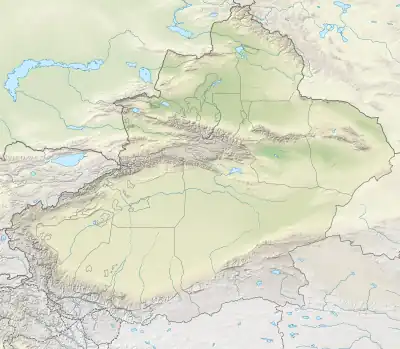 Typical artifacts of the TMP ("Terminal Middle Paleolithic" ~50–38 ka BP) techno-complex found in the Tongtiandong Cave site of Northwest China (1: Levallois core; 2: Discoid core; 3: Levallois flake; 4,5,6: Levallois points; 7,10,11: Mousterian point; 8,9: Scraper; 1–11).[1] | |
.png.webp) Location in China  Tongtiandong (Xinjiang) | |
| Region | Xinjian China |
|---|---|
| Coordinates | 47°00′22″N 85°58′48″E / 47.006093°N 85.980127°E |
| History | |
| Founded | 46,000–44,000 BP cal |
| Periods | Paleolithic China |
Tongtiandong (Chinese: 通天洞, Tōngtiāndòng) is an archaeological site in the Xinjiang Autonomous Region of China, just to the south of the Altai mountains. The site had hunter-foraging human activity circa 40,000 BP (the Mousterian cultural layer was radiocarbon dated to approximately 46,000–44,000 BP, calibrated).[1][2][3]
Cave
Until the discovery of Tongtiandong, the typical Mousterian techno-complex had not been identified in China, but the whole reduction sequence of the Mousterian techno-complex has now been identified in Tongtiandong cave.[4]
From Tongtiandong and other sites, a general distributional pattern of different techno-complexes between Mongolia-Siberia and northern China can be established, for the dates between 50,000 and 32,000 cal BP.[1]

1: Okladnikov Cave; 2: Strashnaya cave; 3: Denisova Cave; 4: Ust Karakol; 5: Kara-Tenesh; 6: Tongtiandong; 7: Mokhovo-2; 8: Kharganyn Gol-5; 9: Orkhon-1; 10: Jinsitai; 11: Sanlongdong cave; 12: Kara-Bom; 13: Luotuoshi; 14: Chikhen Agui; 15: Tsagaan Agui; 16: Voenny Hospital; 17: Kamenka; 18: Tolbaga; 19: Tolbar-4; 20: Nwya Devu; 21: Lenghu; 22: Yushuwan; 23: Lenghu-.1; 24: Shuidonggou-2; 25: Changweigou; 26: ZS08; 27: Wulanmulun; 28: Longquandong; 29: Zhijidong; 30: Fangjiagou; 31: Zhaozhuang; 32: Laonainaimiao; 33: Xiachuan (Fuyuhe); 34: Xibaimaying; 35: Xigouwan; 36: Xiaogushan; 37: Mingyuegou; 38: Zhoujiayoufang; 39: Guxiangtun; 40: Zhalainuoer; 41: Shiyu; 42: Zhoukoudian Upper Cave.[5]
Terminology
- TMP: Terminal Middle Paleolithic (~50–38 ka BP)
- IUP: Initial Upper Paleolithic (~43-32ka BP)
References
- 1 2 3 Zhao, Chao; Wang, Youping; Walden, John P. (3 November 2022). "Diachronic shifts in lithic technological transmission between the eastern Eurasian Steppe and northern China in the Late Pleistocene". PLOS ONE. 17 (11): e0275162. Bibcode:2022PLoSO..1775162Z. doi:10.1371/journal.pone.0275162. ISSN 1932-6203. PMC 9632798. PMID 36327263.
- ↑ Betts, Alison; Vicziany, Marika; Jia, Peter Weiming; Castro, Angelo Andrea Di (19 December 2019). The Cultures of Ancient Xinjiang, Western China: Crossroads of the Silk Roads. Archaeopress Publishing Ltd. p. 10. ISBN 978-1-78969-407-9.
"Recent excavations at the cave site of Tongtiandong in the southern Altai have revealed evidence for human activity at around 40 k BP (Yu and He 2017), and one other stratified but undated preBronze Age context is known, from the site...
- ↑ "45,000-Year-Old Stone Tools Recovered in China - Archaeology Magazine". Archaeology. 2018.
- ↑ Zhao, Chao; Wang, Youping; Walden, John P. (3 November 2022). "Diachronic shifts in lithic technological transmission between the eastern Eurasian Steppe and northern China in the Late Pleistocene". PLOS ONE. 17 (11): e0275162. Bibcode:2022PLoSO..1775162Z. doi:10.1371/journal.pone.0275162. ISSN 1932-6203. PMC 9632798. PMID 36327263.
The typical Mousterian techno-complex was long considered absent from China due to a lack of convincing evidence [59]. However, recent discoveries reveal unequivocal evidence of this techno-complex distributed sporadically across peripheral areas of Northwest and Northeast China. At Tongtiandong Cave in Northwest China, the whole reduction sequence of the Mousterian techno-complex has been identified. This sequence comprised Levallois flake cores, Levallois flakes, points, and denticulates
- ↑ Zhao, Chao; Wang, Youping; Walden, John P. (3 November 2022). "Diachronic shifts in lithic technological transmission between the eastern Eurasian Steppe and northern China in the Late Pleistocene". PLOS ONE. 17 (11): e0275162. Bibcode:2022PLoSO..1775162Z. doi:10.1371/journal.pone.0275162. ISSN 1932-6203. PMC 9632798. PMID 36327263.
 This article incorporates text by Zhao Chao available under the CC BY 4.0 license.
This article incorporates text by Zhao Chao available under the CC BY 4.0 license.